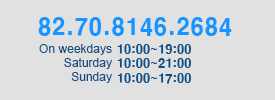| |
| Reasons for Review Rhinoplasty and the Surgical Method |
| |
| Overly High or Low Nose |
| Primary surgery could have been performed based on the wrong surgical plan. |
|
Review surgery gives the nose a proper height through extensive consultation with patients and close analysis,
carrying no special risk and likely to produce a good result. |
|
|
|
| |
| Sagging or Lowered Nasal Tip |
| Primary surgery was unable to build a supporting structure and the nasal tip droops and lowers as time passes. |
|
| Review surgery builds a soft, strong structure at the nasal tip with autologous cartilage and maintains the proper shape of the nasal tip. |
|
|
|
| |
| Blunt Nasal Tip |
| Primary surgery was unable to remove enough subcutaneous fat on the nasal tip, or may have grafted cartilage in too wide an area. |
|
| Primary surgery was unable to remove enough subcutaneous fat on the nasal tip, or may have grafted cartilage in too wide an area. |
|
|
|
| |
| Crooked or Bent Nose |
| Primary surgery may have overly augmented the nasal tip, or the grafted nasal septal or rip cartilage may have been crooked in the first place. This usually gets better as time passes. |
|
| Review surgery lowers the nasal tip that is receiving pressure due to the height to reduce the pressure, and add cartilage in the opposite side of the crooked cartilage to give balance. |
|
|
|
| |
| Reddened Nasal Tip or Noticeable Implants |
| These are common side effects that can occur when implants are used on the tip of the nose (different from covering cartilage on implants) and the skin is thinned. |
|
| Nasal tip surgery could be performed using cartilage if the dermal thickness is normal, but if the skin is severely thinned, the skin on the tip is reinforced with artificial skin or deep temporal fascia. |
|
|
|
| |
| Protruded Outlines of Implants |
| The implant is too thick, its width doesn’t match the outlines of the nasal bone, or the skin is too thin. |
|
| Review surgery inserts thinner implant or ones well-matched to the shape of the nasal bone. If the skin is too thin, the implant is blanketed by artificial skin or a deep temporal fascia. |
|
|
|
| |
| Nose Infected by or Allergic to Implants |
| Infection and allergy could occur because from a variety of causes but they are not common. |
|
| Review surgery changes the type of implant or builds the nose using costal or nasal septal cartilage without implants. |
|
|
|
| |
| Protruded ’11’-Shaped Implant Outlines |
| Overly wide or narrow implants compared to the nasal bone width may have been stacked too high. |
|
| Review surgery inserts implants well-suited to the outlines of the nasal bone. |
|
|
|
| |
| Relocated or Moving Implants |
| Implants may have been inserted in the wrong place rather than on the center under the periosteum. |
|
| Review surgery inserts new implants on the center under the periosteum. |
|
|
|
| |
| Upturned Nose due to Contracture |
| If contracture has developed over a long period of time, review surgery may be ineffective in most cases. If the nasal tip has undergone inappropriate surgery or chronic inflammation has developed, the nasal tip could continue to rise. |
|
| Review surgery completely removes the adhesion of scar tissue under the skin, sufficiently lowers the skin on the nasal tip, and effectively supports the tip with nasal septal or rib cartilage. A pretty nasal tip can be maintained without relapse. |
|
|
|
| |
| Nasal Alar Collapse |
| The nasal tip and alae collapse and block entrance to the nostrils when inhaling. This happens when the nasal alar cartilage is severely damaged or cut off. |
|
| Review surgery reinforces the damaged nasal alar cartilage with ear cartilage. |
|
|
|
| |
| Unnatural Nasal Ridge due to Unsuccessful Aquiline Nose Correction |
| If primary surgery was unable to sufficiently correct the aquiline nose, it could remain as or return to its aquiline shape even after surgery. Also, if an aquiline nose is excessively corrected, depression deformity could occur. |
|
| Review surgery additionally corrects the aquiline nose that underwent insufficient primary surgery or fills in depressions due to excessive surgery with cartilage or other materials. |
|
|
|
| |
| Noses Illegally Injected with Silicon or Paraffin |
| If injected with silicon or paraffin by unlicensed practitioners, the nose could suffer serious problems to its skin including discoloration, necrosis or discharge of the injected material. |
|
| Injected materials should be immediately removed as much as possible and antibiotics should be prescribed. A, rhinoplasty then needs to be performed using autologous tissue. |
|
|
|
| |
| Asymmetric Nostrils |
| Pre-surgery asymmetry may have remained or the balance of the nasal septal and alar cartilage may have been broken due to primary surgery. |
|
| If it turns out through close examination of pre-surgery photos that asymmetry was made by the primary surgery, the balance of the nasal septal and alar cartilage is restored to make pre-surgery symmetric nostrils. |
|
|
|
| |





































![2013年消费者最值得信赖的品牌大奖
[鼻部整形/面部轮廓整形领域]荣获大奖](/images2/main/partners_000.jpg)
![2013年韩国消费者最受欢迎品牌第一名
[鼻部整形/面部轮廓整形领域]荣获大奖](/images2/main/partners_03.jpg)









